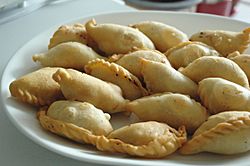Gujia facts for kids
 |
|
| Type | Dumpling |
|---|---|
| Course | Dessert |
| Place of origin | Indian subcontinent |
| Main ingredients | Suji or Maida flour, wheat flour, khoa |
Gunjiya, also known as Gughara, Pedakiya, karanji, Kajjikayalu, Somas, or Karjikayi, is a delicious sweet dumpling. It comes from the Indian subcontinent, which includes countries like India. This tasty treat is deep-fried and often enjoyed during special celebrations.
Gunjiya is made with a dough from suji (a type of coarse flour) or maida (all-purpose flour). The dough is then filled with a sweet mixture. This filling usually includes sweetened khoa (which are milk solids, also called mawa) and dried fruits. After being filled, the dumplings are fried in ghee, a type of clarified butter. The first mention of a similar sweet was in the 13th century. Back then, a mix of jaggery (a type of sugar) and honey was wrapped in wheat flour and dried in the sun.
Contents
Making Gunjiya
Making Gunjiya is a bit like making a samosa, another popular snack. However, Gunjiya looks more like an empanada, which is a half-moon shaped pastry.
What's inside?
The Gunjiya is shaped like a half-moon. It is filled with a sweet mixture. This mix often has grated and roasted dried fruits, khoa, and grated coconut. Sometimes, a little bit of suji is added. This gives the filling a nice, slightly grainy texture.
When do people eat Gunjiya?
People especially make and eat Gunjiya during important festivals in India. These include Teej, Holi, and Chhath. It's a special treat for these festive times.
Gunjiya Around India
Many parts of India have their own versions of Gunjiya. These dishes are similar but might have different fillings or names.
Regional names
Gunjiya is popular in states like Uttar Pradesh, Rajasthan, Gujarat, and Bihar. People enjoy it during Holi and Diwali festivals. In Bihar, the dry versions are called Pedakiya. These are very popular and sometimes used as holy offerings during Chhath.
There are two main types of Pedakiya in Bihar:
- One type uses suji or rawa (Semolina). The suji is roasted in ghee with sugar, almonds, cardamom, raisins, and other nuts. Then, it's deep-fried.
- The other type uses pure khoa. The khoa is mixed with nuts and sugar and then deep-fried.
Other similar sweets
This sweet is known by different names across India:
- In Gujarat, it's called Ghughra.
- In Maharashtra, it's known as Karanji.
- In Odisha, it's also called Karanji.
- In Tamil Nadu, it's called Somas.
- In Telangana, it's Garijalu.
- In Andhra Pradesh, it's Kajjikayalu.
- In Karnataka, it's called Karjikayi or Karigadubu.
All these are fried sweet dumplings. They are made from wheat flour and filled with sweet coconut or other delicious fillings. In Goa, people make a similar sweet called nevri or neuri. Goans enjoy these during their festivals, like Ganesh Chaturthi for Hindus and Christmas for Christians. In Odisha, the karanji can have a coconut or a curd cheese filling.

